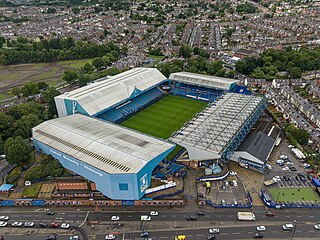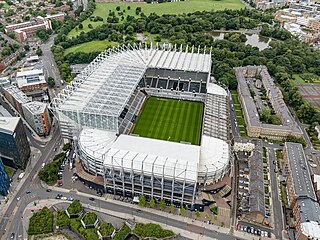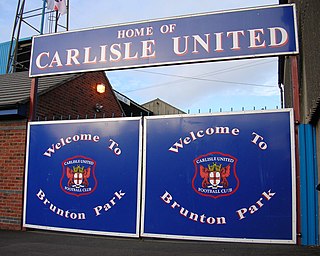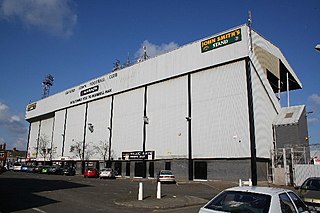
Hillsborough Stadium is a football stadium in Sheffield, England. It has been the home of Sheffield Wednesday since opening in 1899.

Cambridge United Football Club is a professional association football club based in the city of Cambridge, England. They compete in EFL League One, the third level of the English football league system.

St James' Park is a football stadium in Newcastle upon Tyne, England. It is the home of Newcastle United. With a seating capacity of 52,350 seats, it is the 8th largest football stadium in England.

Loftus Road is a football stadium in White City, London, England, which is home to Queens Park Rangers.

Adams Park is an association football stadium in High Wycombe, Buckinghamshire, England. Built in 1990, it is the home ground of the local Wycombe Wanderers in League One. It was also leased from 2002 to 2014 to the rugby union club London Wasps from Aviva Premiership, and from 2016 to 2020 to the Reading F.C. Women football club. From the 2003/04 season to the 2005/06 season, the stadium was officially called Causeway Stadium, named after its sponsor Causeway Technologies.

Portman Road is a football stadium in Ipswich, Suffolk, England, which has been the home ground of Ipswich Town F.C. since 1884. The stadium has also hosted many England youth international matches, and one senior England friendly international match, against Croatia in 2003. It staged several other sporting events, including athletics meetings and international hockey matches, musical concerts and Christian events.

St Andrew's, known for sponsorship reasons as St. Andrew's @ Knighthead Park, is an association football stadium in the Bordesley district of Birmingham, England. It has been the home ground of Birmingham City Football Club for more than a century.

Carrow Road is a football stadium in Norwich, Norfolk, England, and is the home of EFL Championship club Norwich City. The stadium is east of the city, near Norwich railway station and the River Wensum.

Bootham Crescent in York, England, was the home of York City Football Club and York City Knights rugby league club. With a capacity of 8,256, it was near the city centre, just over a mile from York railway station. As of February 2023 the ground has been fully demolished to make way for the building of new houses.

Brunton Park is a football stadium and the home of Carlisle United. It is situated in the city of Carlisle and has a certified capacity of 17,949. The ground opened in 1909. Brunton Park's grandstand burned down in 1953 and the stadium flooded completely in 2005 and again in 2015.

Glanford Park is a football stadium in Scunthorpe, Lincolnshire, England, and is the home of National League North team Scunthorpe United.

Blundell Park is a football ground in Cleethorpes, North East Lincolnshire, England and home to Grimsby Town Football Club. The stadium was built in 1899, but only one of the original stands remains. The current capacity of the ground is 9,052, after being made all-seater in summer 1995, reducing the number from around 27,000. Several relegations in previous years meant the expansion seating was also taken away; that reduced the capacity further from around 12,000 to what it is now.

The County Ground is a stadium located near the town centre of Swindon, Wiltshire, England, and has been home to Swindon Town Football Club since 1896. The current capacity of 15,728, all-seated, has been at that level since the mid-1990s. A record attendance of 32,000 was set on 15 January 1972, against Arsenal in the third round of the FA Cup. North of the football stadium is Swindon Cricket Club, with their pitch also named The County Ground following its use by the football club from 1893 until 1896.

Roots Hall is a football stadium located in Southend-on-Sea, Essex, England. The stadium is the home ground of the Vanarama National League team Southend United. With a capacity of 12,392, Roots Hall is the largest football stadium in Essex. During the early 21st century, there was lengthy discussion of a new 22,000 seat stadium at Fossetts Farm, but a change of ownership in 2023 seemingly ended prospects of that development.

Gresty Road or the Alexandra Stadium, currently known as the Mornflake Stadium for sponsorship reasons, is a football stadium in Crewe, Cheshire, England. The home ground of Crewe Alexandra, it has an all-seated capacity of 10,153.

New Grosvenor Stadium and Drumbo Park is a multi-purpose stadium in Ballyskeagh, County Down, Northern Ireland. It is currently used for football matches and greyhound racing, the latter is operating under the name Drumbo Park. The stadium currently has a total capacity of 1,500 which 790 can be seated, however this is split to a capacity for football matches of 1,500 and a capacity of 1,000 for greyhound racing.

Bridge Road, also known as the Glassworld Stadium for sponsorship purposes, is a football stadium in Impington, a small village connected to Histon in Cambridgeshire. The ground is owned by a trust called Histon Football Club Holdings, who guarantee the use of the facility for sports purposes. Histon F.C. rent the ground from the trust for free.
Whaddon Road, known as the Completely-Suzuki Stadium for sponsorship reasons, is a football stadium in Cheltenham, England. It is the home ground of Cheltenham Town F.C. It has a total capacity of 7,066, with a mixture of seating and terracing. The ground's official name was the Victory Sports Ground until April 2009 when it was renamed the Abbey Business Stadium through a sponsorship deal. It was announced on 13 July 2015 that the club had agreed a three-year deal to rename the stadium The World of Smile Stadium, but the deal ended after only one year and the stadium was renamed LCI Rail Stadium in 2016–17, before being named "Jonny-Rocks Stadium" in 2018–19, and "Completely-Suzuki Stadium" in 2022.

Stadion, currently known as Eleda Stadion for sponsorship reasons, is a football stadium in Malmö, Sweden and the home of Allsvenskan club Malmö Fotbollförening, commonly known as Malmö FF. In UEFA competitions, the stadium has also been known as Malmö New Stadium and formerly known as Swedbank Stadion for sponsorship reasons. The stadium was named after Swedish-based banking group Swedbank, which owned its naming rights between 2007 and 2017. Apart from being the home of Malmö FF, Stadion has also hosted senior and youth international matches.

The Recreation Ground, currently known as The EBB Stadium at The Recreation Ground for sponsorship reasons and informally known as The Rec, is a football ground in Aldershot, Hampshire, England. Football matches have been played there since 1927 when Aldershot was founded. The ground hosted league football between 1932 and 1992 when Aldershot were members of the Football League. Its current tenants Aldershot Town have used the ground since forming in 1992 and the ground once again hosted league football between 2008 and 2013.
























